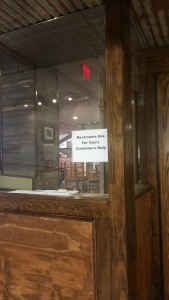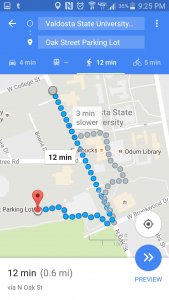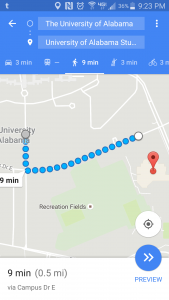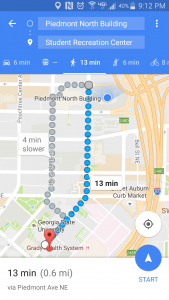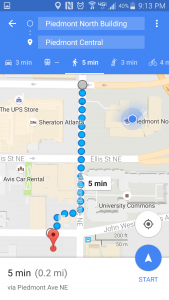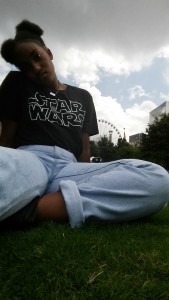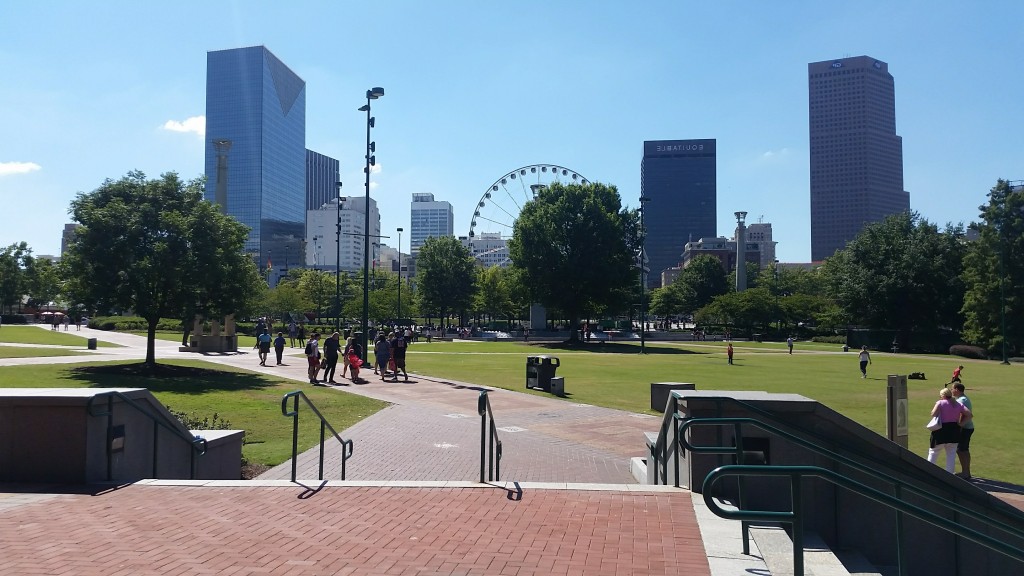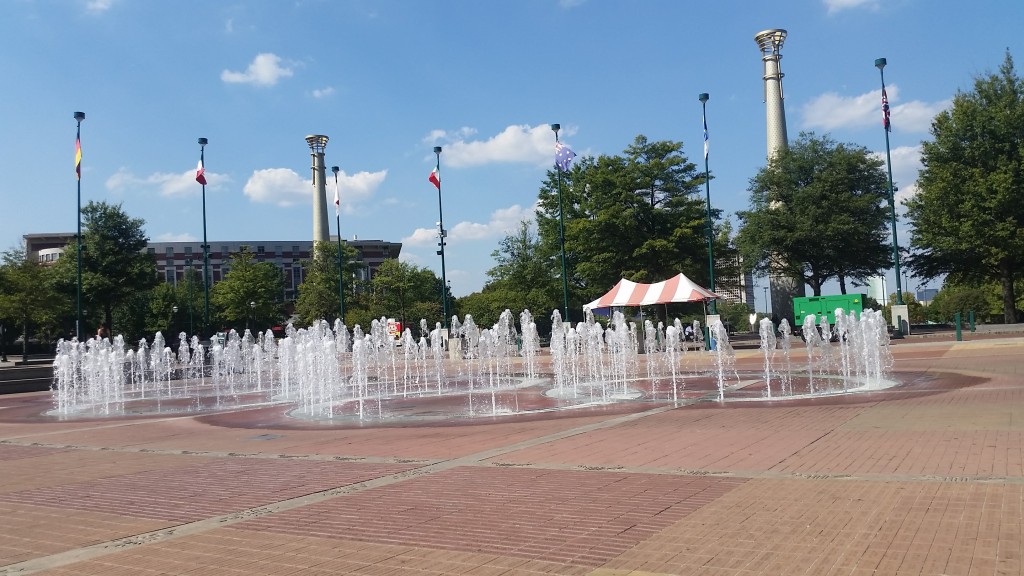Underground Atlanta, built and opened in 1969, was a retail and entertainments district. The site was mostly built on the idea to bring a public night life scene to the heart of the city. However in 1980, the district closed due to the construction of the MARTA transit station and later reopened at the end of the decade. During this time, the area was revamped and then placed on the National Register of Historic Places by civic and business leaders. However, due to its location and design, the historic site has begun to fail among attraction and business in recent years.
Underground Atlanta is located at the heart of Atlanta right before Woodruff Park, connected to the Atlanta Five Points MARTA Stations. Its location connected to the station could be one of the factors as to why it’s set for failure. One would believe that because the site is connected to a stopping point of transit stations that people who take these would think to go through the underground shopping area. However, most would probably avoid it nowadays due to some speculation. Because those that are assumed to take and rely on public transportation (i.e., the middle and lowers working class), the subject and fear of violence and crime is speculated to occur. Although the area itself is not meant to bring this and is set to be a family-friendly daytime facility and then a nightlife hangout, the latter seems to be one of the reasons for its failure.
Because the late night club came into effect among the 1970s, Underground Atlanta contributed to this by attempting to attract the goers of these nightlife events to its venues. Because over the half of Atlanta’s population is of African Americans, this tactic was used to attract that main particular audience. And since the black community was mainly targeted as the general audience for Underground Atlanta, white counterparts would feel unsafe to step into the district due to the rise of crime and violence that would most likely occur. Even though the area is set to be a lively attraction despite its dark location, excessive crime rates have caused attraction to stir away and business to close down. According to Galen Frysinger, on the wake of the Rodney King trial in 1992, the area was looted and destructed by rioters causing a 40% decline in sales. Because of this, marketing campaigns were used to restore a positive public image but still barely made it even during the time of the 1996 Olympics.
Violence and crime wasn’t the only thing driving tourists and potential business away, but the businesses themselves would set to leave the district. From my own visits to the districts, most of them are minority-owned merchants consisting of small businesses in an urban area. The amount of potential customers and consumers vary from time to time but to my own speculation, an average amount of visitors wander around the area in the daytime. I’ve yet to see what the area is like in the night time but however, due to my own safety and paranoia, even if I were to be with somebody, the desertedness of the area, especially at night is something I would avoid. It would seemed to me that because these are small minority-owned businesses that they’re usually have multiple sales and promotions going on with their items at reasonable prices to attempt to persuade potential customers to purchase their products. I would recommend to somebody to even consider shopping at Underground Atlanta because of the “cute” and inexpensive princes they have down there. However, because it only takes so much for small businesses to thrive, half of the merchant stores in Underground is set to be leased and is closed down. According to Michael Epps’ (2016) blog posts, he discussed with merchants about the decline of business in the area and they responded by explaining that the stores would relocate to other areas such as Midtown Atlanta or mall outlet facilities. I can tell you that the only major businesses I’ve seen in Underground Atlanta is Journeys and Foot Locker (including Kid Foot Locker), both of which are major show stores that carry major shoe brands. And even when I visited Journeys once my visit there, there were barely any potential consumers in the store comparing the the smaller businesses. Not only had the major businesses relocated out the district, one is particular, The World of Coca-Cola closed their Underground Atlanta location and relocated near Centennial Olympic Park in 2007. the reason as to the relocation might have been if brought into a more open and public area that the business wouldn’t be near where the crime was as well as to protect its own positive public image by no longer being among associations of such crimes.
Afar from its crimes, its businesses leaving and declining, many efforts have been made to keep the district from closing a second time. In 2004, bars within the facility were allowed to have a 4 AM closing time which is 90 minutes later than the rest of the city. Also, due to its locations, once again, although the area is blocks away from other major sites, its surroundings have also stirred people away from visiting. Surrounded by abandoned buildings and struggling and homeless individuals have caused the area to appear as a dead zone. The only time when the area would be highly populated is on the turn of the new year of the annual Peach Drop that has been effective since its reopening in 1989. Although recent news that covered the drop may not occur due to the district dying out and the decline of business, other new sources have stated that the area is being brought by real estate for $8.8 million. According to Katie Lelsie (2014) of WSB 95.5 FM Radio, the major of Atlanta, Kasim Reed, would have sold the district to a developer from South Carolina for $25.75 millions to convert the area into a mixed-use environment with grocery stores and above-ground apartments to strike business in. Although this concept seems like a grand idea to bring back businesses and potential and even then, residential, consumers to the district, it would still be surrounded by the abandonment of other buildings casting a shadow of potential violence and crime to occur.
But because half of the area is closed down, that doesn’t mean violence and crime have circulated recently. Among my very few visits within the area, there would be security guards looking about the closed areas stopping any potential trespassers. I’ve personally have face two separate times where I hadn’t realized there areas we weren’t allowed to be in let alone sit in. The first one occurred in late September where I as with my friend taking photographs of her for a personal photography project. We were among the same level where the food court was, only along the bridges and terraces outside where some of the nightclubs would be located at. While walking down some stairs, a security guard warned us that we couldn’t go down there nor take pictures down there because the area was closed. The second incident happened where me and two of my friends went to Underground because one of them was the photographer taking pictures for a photoshoot while me and other were the subjects. While we were in the food court, we were in a further area that was still connected to the main food court but was being watched over by two security guards. While the food court was open and although no one but there three of us including the two guards were in that back area, they came up to us and informed us that we would have to speak to management to take pictures in that one are because it was closed down.
Now among these two incidents, the first one did not upset me or my friend because I was just going with whatever areas I could find to take pictures in. However, the second one upset all of us. The reason the latter upset us all because we found it unfair that they wouldn’t even let us use that area to take pictures in. We weren’t being whining or complaining about it because we also discussed how if we were to take pictures at Underground Atlanta and post them among social media and if people inquired about where the pictures were taken that when we told them that it’d be a promotion for the area bringing exposure and advising others to go check out the area themselves not only to take pictures but to go as tourists and eventually as regular visitors.
Because of that incident, violence or crime, or the dead zone ghosttown-like abandonment of the area wouldn’t be the main things that have driven people away from visiting the attraction, but the closed down locations and of being stirred away from certain areas has ceased the tourist attraction experience from expanding the areas, documenting them and recommending and sharing to others to follow suit. While Underground Atlanta still has that golden vintage-like interior, design and experience to become lively again from time to time, whether if it’s during the nightlife or towards the end of the year for the Peach Drop, it’s still a worn out, dark and dreary but nostalgic area that wants to bring people in but also sometimes force them to enter and stay out.

